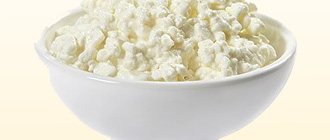Authorized Products
The diet for lactase deficiency in adults includes:
- Soy milk, soy formulas and soy products.
- Lean meat, poultry, fish in any preparation, but preference is given to boiled and steamed dishes during the period of diarrhea.
- Soups are prepared in a weak broth with cereals and vegetables. You can add meatballs and egg mixture.
- Low lactose milk formulas.
- Any vegetable oils.
- All fruits and vegetables are fresh and prepared. Legumes. Fruit and vegetable juices. You can make jelly, compotes, jellies, natural marshmallows, preserves and jam from fruits.
- Eggs in any form.
- Pasta is made from wheat flour, but you need to be sure that it does not contain additives. In this regard, it is better to prepare homemade noodles and homemade bread using only flour.
- Ready-made bread without whey.
- Any cereals. Porridges are prepared with water or broth. You can prepare a variety of casseroles and puddings from cereals and pasta without adding milk.
- Lard.
- Any nuts.
- Jam, honey, syrups.
- Any type of sugar, saccharin.
- Alcoholic drinks (wine, cider, beer).
- Calcium-fortified juices and soy products.
- Drinks include tea, weak coffee, cocoa prepared with water, rosehip decoction and various juices.
Depending on portability, you can include:
- High-quality ripened cheeses: the longer they ripen, the less milk sugar they contain, so hard and semi-hard cheeses can be consumed.
- Fermented milk products and fatty cottage cheese.
- Butter, heavy cream - they contain less milk sugar, so their use in small quantities is allowed. The higher the fat content, the lower the milk sugar content. In addition, all sweet dairy products may also be well tolerated.
This is due to the fact that lactose is also broken down by sucrose α-glucosidase , and the addition of the latter to a dairy product increases lactose tolerance.
Sources of vitamin A : liver, carrots, parsley, soy, sorrel, viburnum, green onions, broccoli, eggs. The B group of vitamins is found in all nuts, beans, broccoli, spinach, liver, peas, sea buckthorn, garlic, millet and oatmeal, pork, tuna, mackerel, broccoli, and lettuce.
Calcium-containing foods: sesame, almonds, flax seeds, tofu, dried rosemary and parsley, poppy seeds, garlic, pistachios, broccoli, spinach, kale, turnip greens, lettuce.
To absorb calcium, it is necessary to ensure that the body receives vitamin D from foods (mackerel, pollock, tuna, sea bass, trout, cod liver, cedar oil, herring) and phosphorus (fatty fish, pumpkin seeds, dried mushrooms, bran, tea). Vegetable oils, nuts, and beet juice improve calcium absorption.
Table of permitted products
Vegetables and greens
| Proteins, g | Fats, g | Carbohydrates, g | Calories, kcal | |
| vegetables legumes | 9,1 | 1,6 | 27,0 | 168 |
| greenery | 2,6 | 0,4 | 5,2 | 36 |
| eggplant | 1,2 | 0,1 | 4,5 | 24 |
| zucchini | 0,6 | 0,3 | 4,6 | 24 |
| cabbage | 1,8 | 0,1 | 4,7 | 27 |
| broccoli | 3,0 | 0,4 | 5,2 | 28 |
| cauliflower | 2,5 | 0,3 | 5,4 | 30 |
| bulb onions | 1,4 | 0,0 | 10,4 | 41 |
| carrot | 1,3 | 0,1 | 6,9 | 32 |
| cucumbers | 0,8 | 0,1 | 2,8 | 15 |
| salad pepper | 1,3 | 0,0 | 5,3 | 27 |
| salad | 1,2 | 0,3 | 1,3 | 12 |
| beet | 1,5 | 0,1 | 8,8 | 40 |
| soybeans | 34,9 | 17,3 | 17,3 | 381 |
| asparagus | 1,9 | 0,1 | 3,1 | 20 |
| tomatoes | 0,6 | 0,2 | 4,2 | 20 |
| Jerusalem artichoke | 2,1 | 0,1 | 12,8 | 61 |
| pumpkin | 1,3 | 0,3 | 7,7 | 28 |
| garlic | 6,5 | 0,5 | 29,9 | 143 |
Fruits | ||||
| apricots | 0,9 | 0,1 | 10,8 | 41 |
| avocado | 2,0 | 20,0 | 7,4 | 208 |
| quince | 0,6 | 0,5 | 9,8 | 40 |
| oranges | 0,9 | 0,2 | 8,1 | 36 |
| pomegranate | 0,9 | 0,0 | 13,9 | 52 |
| grapefruit | 0,7 | 0,2 | 6,5 | 29 |
| pears | 0,4 | 0,3 | 10,9 | 42 |
| kiwi | 1,0 | 0,6 | 10,3 | 48 |
| dogwood | 1,0 | 0,0 | 10,5 | 44 |
| lemons | 0,9 | 0,1 | 3,0 | 16 |
| mango | 0,5 | 0,3 | 11,5 | 67 |
| tangerines | 0,8 | 0,2 | 7,5 | 33 |
| nectarine | 0,9 | 0,2 | 11,8 | 48 |
| peaches | 0,9 | 0,1 | 11,3 | 46 |
| apples | 0,4 | 0,4 | 9,8 | 47 |
Berries | ||||
| Red currants | 0,6 | 0,2 | 7,7 | 43 |
| black currant | 1,0 | 0,4 | 7,3 | 44 |
Nuts and dried fruits | ||||
| flax seeds | 18,3 | 42,2 | 28,9 | 534 |
Cereals and porridges | ||||
| buckwheat (kernel) | 12,6 | 3,3 | 62,1 | 313 |
| semolina | 10,3 | 1,0 | 73,3 | 328 |
| oat groats | 12,3 | 6,1 | 59,5 | 342 |
| cereals | 11,9 | 7,2 | 69,3 | 366 |
| pearl barley | 9,3 | 1,1 | 73,7 | 320 |
| Wheat groats | 11,5 | 1,3 | 62,0 | 316 |
| millet cereal | 11,5 | 3,3 | 69,3 | 348 |
| white rice | 6,7 | 0,7 | 78,9 | 344 |
| barley grits | 10,4 | 1,3 | 66,3 | 324 |
Flour and pasta | ||||
| pasta | 10,4 | 1,1 | 69,7 | 337 |
Confectionery | ||||
| jam | 0,3 | 0,2 | 63,0 | 263 |
| jam | 0,3 | 0,1 | 56,0 | 238 |
Dairy | ||||
| soy milk | 3,3 | 1,8 | 5,7 | 54 |
| kefir | 3,4 | 2,0 | 4,7 | 51 |
| acidophilus | 2,8 | 3,2 | 3,8 | 57 |
| yogurt | 4,3 | 2,0 | 6,2 | 60 |
Cheeses and cottage cheese | ||||
| cheddar cheese | 23,0 | 32,0 | 0,0 | 392 |
| cottage cheese | 17,2 | 5,0 | 1,8 | 121 |
| curd tofu | 8,1 | 4,2 | 0,6 | 73 |
Meat products | ||||
| boiled beef | 25,8 | 16,8 | 0,0 | 254 |
| boiled veal | 30,7 | 0,9 | 0,0 | 131 |
| rabbit | 21,0 | 8,0 | 0,0 | 156 |
Bird | ||||
| boiled chicken | 25,2 | 7,4 | 0,0 | 170 |
| turkey | 19,2 | 0,7 | 0,0 | 84 |
Oils and fats | ||||
| vegetable oil | 0,0 | 99,0 | 0,0 | 899 |
| butter | 0,5 | 82,5 | 0,8 | 748 |
Non-alcoholic drinks | ||||
| mineral water | 0,0 | 0,0 | 0,0 | — |
| green tea | 0,0 | 0,0 | 0,0 | — |
| black tea | 20,0 | 5,1 | 6,9 | 152 |
Juices and compotes | ||||
| Orange juice | 0,9 | 0,2 | 8,1 | 36 |
| Cherry juice | 0,7 | 0,0 | 10,2 | 47 |
| Strawberry juice | 0,6 | 0,4 | 7,0 | 31 |
| tangerine juice | 0,8 | 0,3 | 8,1 | 36 |
| Apple juice | 0,4 | 0,4 | 9,8 | 42 |
Fully or partially limited products
Depending on the severity of the deficiency, the following are excluded to varying degrees:
- Milk (powdered, whole, condensed), ice cream, cheeses, kumiss, cottage cheese, whey, cream, sour cream, buttermilk, butter.
- Bakery products, confectionery products with butter cream, cakes, pies, milk sweets, caramel, chocolate bars, cocoa powder.
- Sausages, semi-finished meat products, ham, canned fish, meat and vegetables, sandwich masses.
- Muesli, chips, croquettes, hamburgers, cheeseburgers.
- Soups in bags and broths, bulk spices, ready-made sauces, ketchup, mustard.
- Mayonnaise and other salad dressings, sauces made with milk.
- Nut butters, ready-made puddings and mashed potatoes.
At the same time, in case of severe flatulence , at first exclude foods that support fermentation: mature beans and peas, raisins, grapes, white cabbage, plums. Limit sugar and yeast baked goods.
Lactase deficiency is a congenital or acquired pathology of the small intestine, in which the lactase enzyme is absent or its activity is reduced.
Another name for the same condition is lactose intolerance.
This disease is accompanied by a syndrome of impaired absorption and digestion of lactose - the so-called milk sugar. All dairy products contain lactose. The concentration of this sugar in cow's milk is approximately 5 g per 100 ml, and in breast milk - 7 g per 100 ml.
Types of lactase deficiency
Depending on the severity, there are two types of lactase deficiency:
- partial (hypolactasia)
- complete (alactasia).
Depending on the origin, lactase deficiency occurs:
- primary (caused by congenital decreased lactase activity with a healthy enterocyte structure)
- secondary (associated with a decrease in lactase activity when the enterocyte is damaged).
Primary lactase deficiency can be:
- congenital (hereditary)
- constitutional (adult type)
- transient (occurs in premature infants and in children who are not sufficiently developed at the time of birth).
Secondary lactase deficiency can develop:
- against the background of an inflammatory process in the small intestine due to infectious genesis (viral or bacterial inflammation)
- for gastrointestinal food allergies (allergy to cow's milk protein)
- with anomalies of an atrophic nature.
Causes of the disease
There are several reasons and factors why lactose is not absorbed by the body:
- genetic predisposition;
- celiac disease;
- acute intestinal infections;
- allergic reaction to gluten;
- allergy to milk proteins;
- gastroenterological diseases in chronic form;
- negative reaction of the body to gastrointestinal diseases previously suffered (complications).
Feature: the problem can be congenital or acquired. In children 0-1 years of age, manifestations of intolerance are temporary in 80% of cases, since their gastrointestinal tract is not yet fully ready for stress, some functions may not work at full capacity, or the body does not produce lactose fully.
Important! Experts identify transient intolerance. It occurs in 90% of cases in children who were born prematurely (premature). This is due to the immaturity of the body’s enzyme systems.
If the problem with lactose intolerance, which is congenital, suggests that you will have to completely abandon products containing it. The acquired form occurs when disturbances in the enzyme production system occur in the body. The following reasons influence this:
- human transmission of intestinal infections;
- pancreatitis (acute or chronic;
- improper diet (in adults);
- weakened immune system.
It is necessary to listen to the body's signals in order to begin treatment as early as possible.
Symptoms of lactase deficiency
Lactase deficiency in adults can be accompanied by the following conditions:
- osmotic (foamy, liquid) diarrhea after eating dairy products
- stomach pain
- flatulence
- weight loss (rare).
Lactase deficiency is characterized by a wide range of symptoms, and no dependence of symptoms on the degree of lactase activity in adult patients was noted. At the same level of enzyme activity, signs of the disease may appear to a greater or lesser extent. However, in all patients, increasing lactose intake causes increased symptoms.
The severity of this pathology is influenced by the severity of malnutrition, dehydration, dyspeptic symptoms (diarrhea, stomach pain), as well as the duration of the disease.
Lactase deficiency: how to determine
Lactase deficiency, the symptoms of which are quite easy to recognize, is very similar to other infant ailments:
- Bloating . After each feeding, the baby experiences severe bloating, fermentation and seething in the intestines and, as a result, gases and cramping colic.
- Pain during bowel movements . Often a baby with this diagnosis experiences diarrhea, in which case the stool has a sour smell of sour milk. As we wrote above, undigested milk simply leaves the body unprocessed.
- The baby sleeps very poorly , and while awake behaves capriciously or apathetically.
- In severe cases, the child begins to lose weight ; in milder cases, growth stops.
- The child vomits a lot and often , his body is dehydrated.
Usually this disease does not in any way affect the baby’s appetite; he can still greedily grab his mother’s breast or bottle nipple.
Symptoms of lactase deficiency in an infant appear in turn - first bloating and gas, then pain and colic, and lastly - stool disorders.
The so-called secondary lactase deficiency, that is, when the production of the lactase enzyme is insufficient, is accompanied by another symptom - green, lumpy stool.
Diagnosis of lactase deficiency
In our clinic, the diagnosis of lactase deficiency is established by a doctor after a thorough study of the symptoms that are troubling the patient and the results of additional diagnostics, which includes special laboratory tests.
Examination of a patient with lactase deficiency includes the following methods:
- breath tests
- analysis of lactase activity in a biopsy sample of the small intestinal mucosa (an invasive technique, the use of which is limited due to the complexity and high cost of the procedure)
- genetic analysis of biopsy material during FGDS.
Diagnostics
A diagnostic examination will help to establish an allergy or lactose intolerance in a child or an adult when negative signs appear. The gastroenterologist conducts a comprehensive examination, taking into account existing external manifestations and symptoms. Examinations are prescribed to rule out problems such as:
- pancreatitis with exocrine insufficiency;
- chronic colitis;
- food poisoning.
To confirm problems with dairy products, a special elimination diet is prescribed. Its essence lies in the fact that for the period prescribed by the doctor, all products of dairy origin, as well as those containing this component, are excluded from the diet. A breath test is performed to obtain additional information about your health status. During preparation for it, it is also recommended to exclude a number of products - dairy for all ages and cigarettes, medications for adult patients. The main essence of a diagnostic examination using a test is to determine the hydrogen content in the air exhaled by a person. Before the procedure, the patient is given a liquid to drink that contains a lot of lactose. There are restrictions - the test is not performed for younger age groups of patients.
Diagnosis includes a blood test for sugar levels. It is carried out immediately after a person has consumed products containing lactose. Feature: the analysis is done on an empty stomach, before taking blood you need to drink a liquid with this component (milk). Afterwards, blood sugar levels are measured at 30-minute intervals. If the values are unchanged, there are no sharp jumps, then the doctor concludes that lactose intolerance occurs.
An analysis is also carried out for the acidity of stool (samplings are carried out in adults and children). Based on the results obtained, the specialist concludes that there is a violation of the enzymatic processing of lactose in the gastrointestinal tract. An additional method of diagnostic examination is a biopsy of the intestinal mucosa.
Having received all the information as a result of the diagnosis, the doctor gives an opinion on the state of health, confirms or refutes the alleged diagnosis and makes prescriptions regarding treatment and preventive programs.
Treatment of lactase deficiency
Treatment of this pathology requires a differentiated approach. The doctor plans the necessary therapy based on the causes of enzyme deficiency and the severity of the disease.
Treatment of lactase deficiency begins with diet therapy, which involves reducing lactose consumption or completely avoiding products that contain it.
Treatment of secondary lactase deficiency should be aimed at eliminating the disease that caused this pathology. At the same time, reducing lactose in the diet is a temporary measure with which you can restore the normal state of the mucous membrane of the small intestine.
It is quite possible for adults suffering from lactase deficiency to stop eating dairy products. Your doctor will provide detailed recommendations regarding nutrition.









